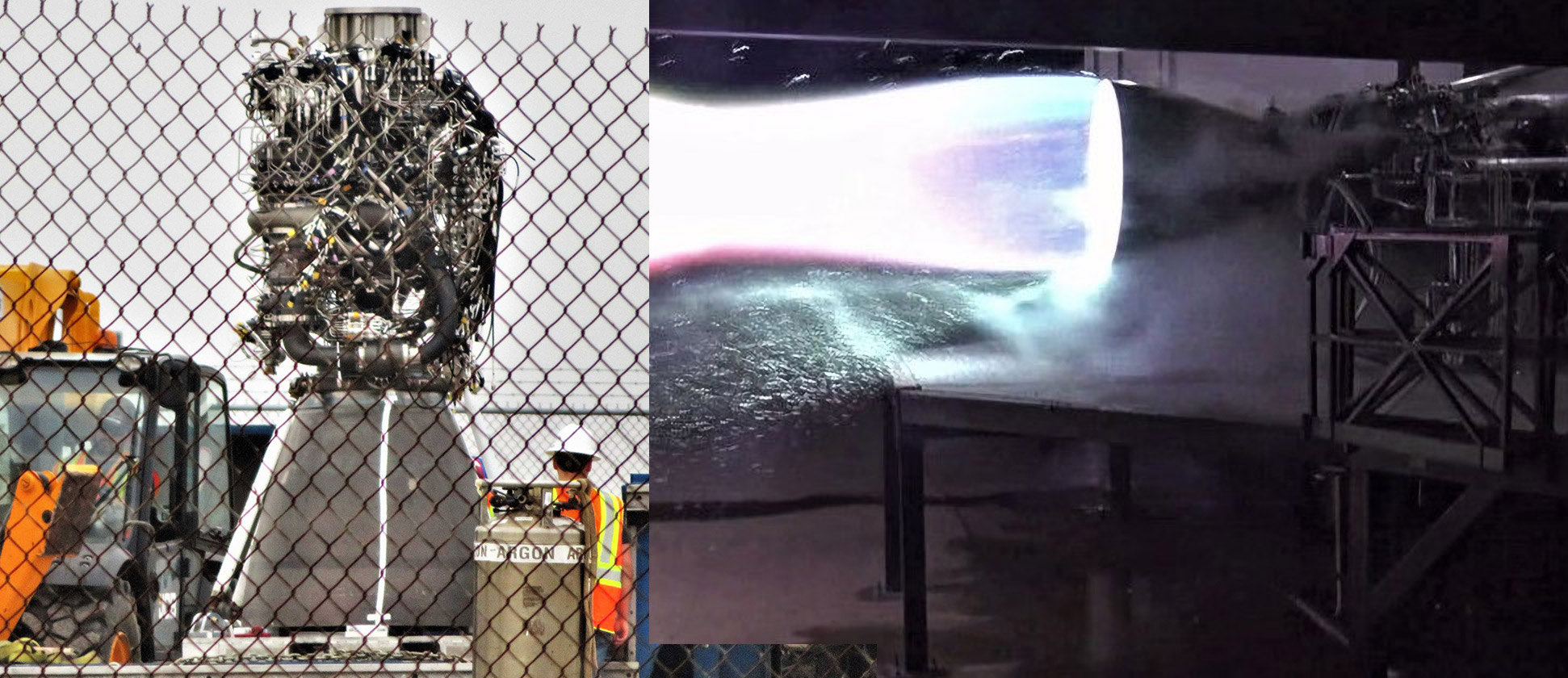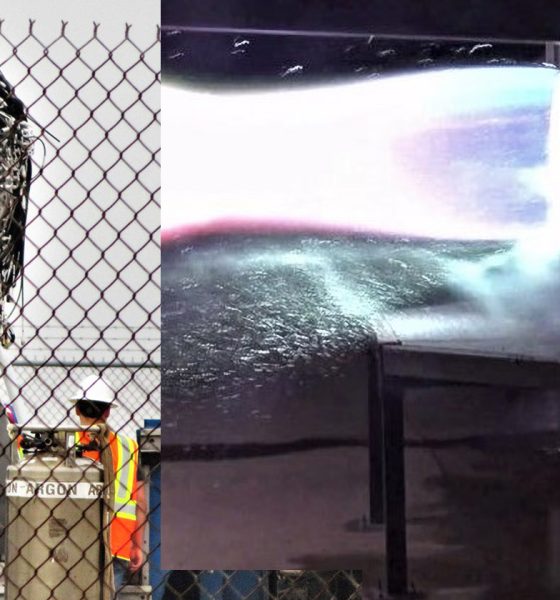

SpaceX
SpaceX begins static Starhopper tests as Raptor engine arrives on schedule
SpaceX has officially begun static ground testing of Starhopper, a full-scale pathfinder Starship prototype meant to support an early series of Raptor-powered hop tests at SpaceX’s South Texas launch site. Simultaneously, the second completed Raptor engine arrived at the site on Monday, March 11th, confirming CEO Elon Musk’s March 8th tweets about the delivery.
While reasonably routine for any rocket test program, the first tanking test of Starhopper effectively marks the first time that SpaceX has begun tests with a more or less fully integrated Starship (previously BFS). Likely performed with liquid nitrogen instead of liquid oxygen/methane, the first few tanking tests will be used to determine the quality of the prototype’s stainless steel tanks – built en
In November 2016, SpaceX began propellant-loading tests of its first finished full-scale Starship (then Big Falcon Spaceship) hardware, a massive carbon composite liquid oxygen tank stretching 12 m (~40 ft) in diameter. Over the course of 2017, SpaceX transitioned from liquid nitrogen to liquid oxygen and ultimately conducted one final burst-test in which the composite tank was pressurized until it exploded, ending full-scale BFR composite testing with a bang. Within 6-12 months, Musk had come to the conclusion that a stainless steel BFR would ultimately be a superior path forward for the rocket and spaceship and attempted (apparently successfully) to get his team of R&D engineers on board with such a radical change so late in the development phase.
Despite the fact that that radical design departure may have occurred as few as 6-8 months ago, SpaceX engineers and technicians have accomplished an extremely rapid development program that will – in part – culminate in the hopefully successful hop testing of Starhopper, the first Starship prototype. While more of a rough testbed than an actual representation of the hardware and structures that will be required for a reusable orbital-class Starship, Starhopper has at least acted as a crash course (either technically or organizationally) on fabricating and assembling stainless steel aerospace structures, a material largely foreign to SpaceX flight hardware prior to late 2018.
Although the early vehicle was less than encouraging, as was the demise of its nosecone as a consequence of improper planning and/or bad workmanship, Starhopper as it now stands might actually be flightworthy in the context of suborbital, subsonic hop tests. Powered by the same or similar Raptors that would power orbital prototypes, Starhopper’s hop tests would optimally provide a wealth of experience and engineering data for both building 9 meter/30 foot-diameter stainless steel rocket sections and operating full-scale Raptor engine(s) in actual flight configurations. Extensive testing with Raptor will help to ensure that the fit and finish of the new engine’s flight-grade avionics and hardware are up to the challenge of safe, reliable, and gentle operations for a nominally crew-rated launch vehicle and spacecraft.
Around two days after Starhopper was briskly transported from its build site to SpaceX’s brand new launch facility, local Twitter account @SPadre (short for South Padre Island) posted a video of tanking test that occurred on March 11th, capturing the sound of venting as the liquid involved turned to gas inside its propellant tank(s). The fact alone that the person behind the camera was allowed to be where they were during the test all but guarantees that this first test was performed with an inert liquid, most likely liquid nitrogen given a massive delivery that occurred the day before (March 10th). In no conceivable world would SpaceX or local law enforcement willingly allow for Starhopper to be loaded – for the first time ever – with even a partial load of liquid methane or liquid oxygen with bystanders barely a few hundred feet distant.

When SpaceX gets to the point that they are confident enough in the structural integrity of Starhopper to begin wet dress rehearsals and tests with actual propellant, it’s a safe bet that the company will cooperate with local law enforcement to block off the lone access road to a distance of at least 1-2 miles, if not more. It’s unclear if local homeowners and residents will be forced to vacate the adjacent Boca Chica Village during testing, but chances are good that nobody will be within several thousand feet of Starhopper when those propellant loading tests begin, let alone actual static fire activity once Raptor(s) are installed.
According to an official SpaceX statement on the progress, propellant load tests and static fires could begin “in the days ahead”, although the spokesperson was under the impression that those tests – as well as initial hop tests – “[would] not be visible from offsite”. Unless SpaceX plans to draw a keep-out zone with a radius of multiple miles, interested observers will almost certainly be able to get close enough to at least catch a glimpse of Starhopper, but the statement still offers an idea of just how focused the company will be on safety during these early tests.
Check out Teslarati’s Marketplace! We offer Tesla accessories, including for the Tesla Cybertruck and Tesla Model 3.

Elon Musk
Elon Musk’s Biggest Revelations on AI, Robots, and the Future of Work from the Moonshots Podcast

Elon Musk’s appearance on the Moonshots with Peter Diamandis podcast was packed with bold predictions, candid admissions, and surprising tech insights. The nearly three-hour conversation covered everything from artificial intelligence to humanoid robots, geopolitics, and the future of work. Here are the top 10 most intriguing takeaways:
-
Aggressive AGI Timeline Predictions
Musk offered a detailed view on when artificial general intelligence (AGI) could emerge, suggesting it may arrive sooner than many expect, emphasizing both transformative potential and risks.
-
U.S. vs. China in the AI Race
He discussed the strategic competition between the United States and China over AI development, noting that geopolitical dynamics will shape how and who leads in the next decades.
-
Future of Job Markets
Musk touched on how AI and automation could reshape employment, predicting massive boosts in productivity alongside potential disruptions in traditional work structures.
-
Clean Energy Transition
A recurring theme was the role of clean energy in future economies, with Musk reiterating the importance of scaling sustainable power generation and storage.
-
Humanoid Robots Are Coming
On the podcast, Musk elaborated on Tesla’s work on humanoid robots, hinting at timelines and applications that go beyond factories to general-purpose assistance.
-
Tesla Roadster “Last Human-Driven Car”
Outside the core discussion topics, Musk teased features of the upcoming Tesla Roadster — calling it “the best of the last of the human-driven cars” and suggesting safety won’t be its main selling point.
-
The Role of AI in Clean Energy and Robotics
Linking AI to both energy optimization and robotics, Musk explained how smarter systems could accelerate decarbonization and task automation across industries.
-
U.S. Innovation Leadership
Musk argued that maintaining American leadership in key tech sectors like AI, space, and robotics should be a national priority, with thoughtful policy and investment.
-
Job Creation vs. Job Elimination
While acknowledging automation’s disruptive effects, he also outlined scenarios where new industries and opportunities could emerge, particularly in AI, space, and advanced manufacturing.
-
Long-Term Vision for Humanity
Throughout the conversation, Musk revisited his long-term philosophical views — including a belief in humanity’s responsibility to become a multi-planetary and technologically empowered species.
Whether you agree with Musk’s optimism or not, the podcast offers a window into the thinking of one of the most influential figures in tech today, in and why his visions continue to spark debate and inspiration.
Elon Musk
Starlink achieves major milestones in 2025 progress report
Starlink wrapped up 2025 with impressive growth, adding more than 4.6 million new active customers and expanding service to 35 additional countries, territories, and markets.

Starlink wrapped up 2025 with impressive growth, adding more than 4.6 million new active customers and expanding service to 35 additional countries, territories, and markets. The company also completed deployment of its first-generation Direct to Cell constellation, launching over 650 satellites in just 18 months to enable cellular connectivity.
SpaceX highlighted Starlink’s impressive 2025 progress in an extensive report.
Key achievements from Starlink’s 2025 Progress
Starlink connected over 4.6 million new customers with high-speed internet while bringing service to 35 more regions worldwide in 2025. Starlink is now connecting 9.2 million people worldwide. The service achieved this just weeks after hitting its 8 million customer milestone.
Starlink is now available in 155 markets, including areas that are unreachable by traditional ISPs. As per SpaceX, Starlink has also provided over 21 million airline passengers and 20 million cruise passengers with reliable high-speed internet connectivity during their travels.
Starlink Direct to Cell
Starlink’s Direct to Cell constellation, more than 650 satellites strong, has already connected over 12 million people at least once, marking a breakthrough in global mobile coverage.
Starlink Direct to Cell is currently rolled out to 22 countries and 6 continents, with over 6 million monthly customers. Starlink Direct to Cell also has 27 MNO partners to date.
“This year, SpaceX completed deployment of the first generation of the Starlink Direct to Cell constellation, with more than 650 satellites launched to low-Earth orbit in just 18 months. Starlink Direct to Cell has connected more than 12 million people, and counting, at least once, providing life-saving connectivity when people need it most,” SpaceX wrote.
Elon Musk
Starlink passes 9 million active customers just weeks after hitting 8 million
The milestone highlights the accelerating growth of Starlink, which has now been adding over 20,000 new users per day.

SpaceX’s Starlink satellite internet service has continued its rapid global expansion, surpassing 9 million active customers just weeks after crossing the 8 million mark.
The milestone highlights the accelerating growth of Starlink, which has now been adding over 20,000 new users per day.
9 million customers
In a post on X, SpaceX stated that Starlink now serves over 9 million active users across 155 countries, territories, and markets. The company reached 8 million customers in early November, meaning it added roughly 1 million subscribers in under seven weeks, or about 21,275 new users on average per day.
“Starlink is connecting more than 9M active customers with high-speed internet across 155 countries, territories, and many other markets,” Starlink wrote in a post on its official X account. SpaceX President Gwynne Shotwell also celebrated the milestone on X. “A huge thank you to all of our customers and congrats to the Starlink team for such an incredible product,” she wrote.
That growth rate reflects both rising demand for broadband in underserved regions and Starlink’s expanding satellite constellation, which now includes more than 9,000 low-Earth-orbit satellites designed to deliver high-speed, low-latency internet worldwide.
Starlink’s momentum
Starlink’s momentum has been building up. SpaceX reported 4.6 million Starlink customers in December 2024, followed by 7 million by August 2025, and 8 million customers in November. Independent data also suggests Starlink usage is rising sharply, with Cloudflare reporting that global web traffic from Starlink users more than doubled in 2025, as noted in an Insider report.
Starlink’s momentum is increasingly tied to SpaceX’s broader financial outlook. Elon Musk has said the satellite network is “by far” the company’s largest revenue driver, and reports suggest SpaceX may be positioning itself for an initial public offering as soon as next year, with valuations estimated as high as $1.5 trillion. Musk has also suggested in the past that Starlink could have its own IPO in the future.








